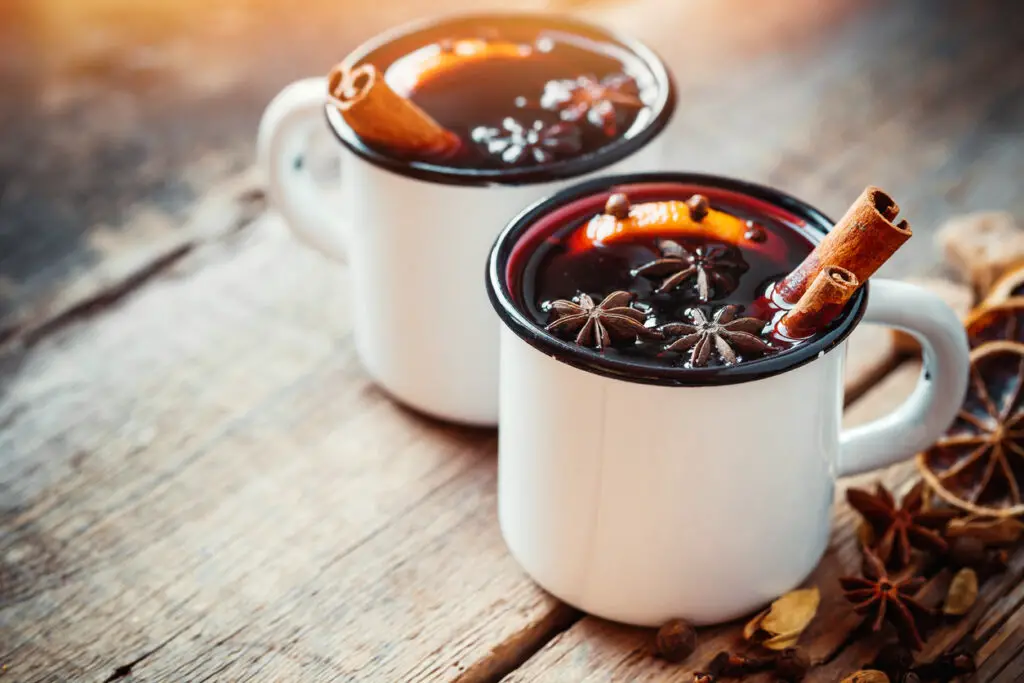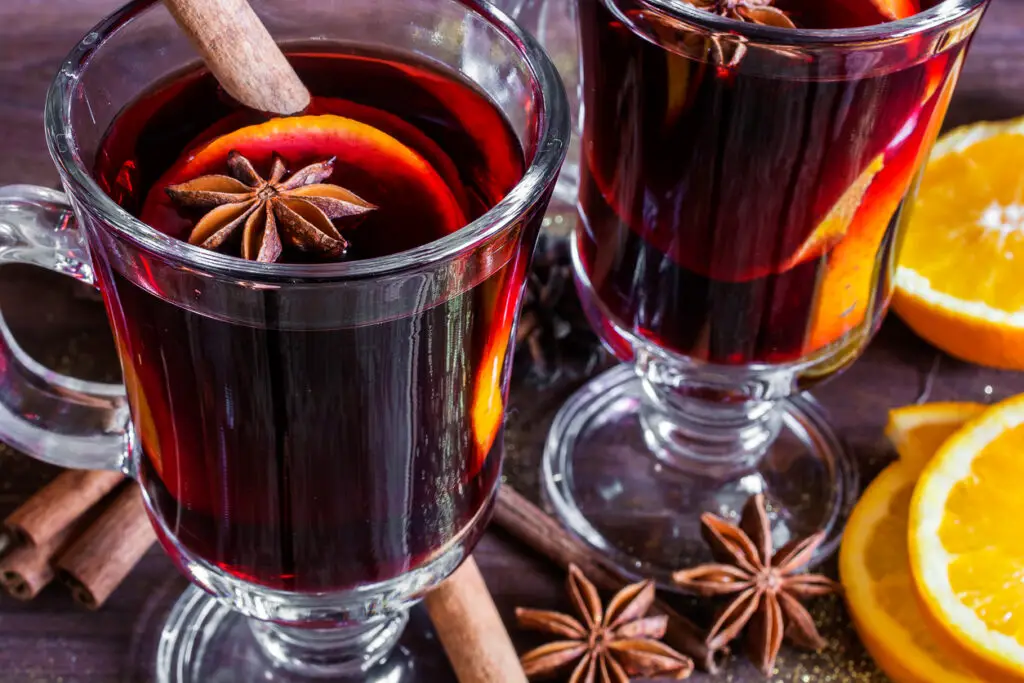As you relax with a warm glass of mulled wine or glühwein in front of your Christmas tree, you may think of it as a festive drink and nothing more. But did you know that your glass of warm wine has lots of health benefits? Is warm wine good for a cold?
The short answer is yes, it is! In fact, warm wine is excellent, especially during cold seasons, which is a perfect remedy to cold thanks to polyphenols found in wine. Polyphenols help with circulation, keeping you warm and toasty during cold winter. Just don’t over do it.
Before looking into specific health benefits mulled wine can have, let’s firstly discuss its ingredients and how it is made.
The History of Warm Wine
As surprising as it may sound, warm wine has historical roots tracing back to the 2nd century. Historically, warm wine was firstly prepared by the Romans. The reason Romans loved mulled wine so much was that it protected their bodies from cold. When Romans conquered many European regions throughout the next century, warm wine spread across their empire and areas they traded with.
Warm wine’s popularity continued increasing throughout the middle ages when Europeans started changing recipes and adding more ingredients. Mulled wine was prepared with spices because people believed it would promote a healthy lifestyle and prevent sickness.
However, over time, the demand for warm wine slowly decreased throughout Europe, excluding Sweden, where its popularity even increased. Warm wine called “Claret” was one of the most famous types in Sweden. This type of wine was made of Rhen variety, honey, sugar, and spices. Another famous Swedish warm wine was called Lutendrank. Besides wine variety and spices, Lutendrank also had milk in it.
There were many alternative names to warm wine throughout history, so in 1609 recipe books started using the collective name glögg. The biggest turning point for glögg came later in the 1890s when people started associating it with Christmas. There was no single recipe for glögg; instead, every wine merchant had their unique recipe, which got distributed throughout the whole of Europe.
Current Day

Over the next decades, mulled wine started spreading outside Europe, gaining global popularity. Nowadays, countries all over the world have their own unique recipes for warm wine. You can find variations from red and white wines to sangria blends and port. Each country’s recipe slightly differs from another, including different spices and wine varieties.
Until now, mulled wine continues to be an integral part of the Christmas celebration for many families alongside its sister drink, mulled cider. Let’s now take a look at several mulled wine recipes, which you can also prepare yourself, and have a great holiday season!
Mulled Wine Recipe
As we have already discussed, different countries use their own unique recipes for preparing mulled wine, but some ingredients are essential no matter which recipe you choose. Let’s see what those ingredients are.
Author Note: You’ll need a bottle of red wine (either Merlot or Cabernet Sauvignon may suit best), ⅓ cup of honey (maple syrup or sweetener), two sticks of cinnamon, an orange, eight whole cloves, 3 to 4 cardamom pods, and an optional ingredient is ⅓ cup of brandy.
If you have all these ingredients ready, let’s get started on preparing delicious mulled wine. First of all, pour the wine into a porringer on medium-high heat (note that the idea is to slightly simmer the wine but never to boil, to avoid burning the alcohol levels).
Crush the cardamom pods with a spoon prior to adding them to a porringer. This is done to release the flavor, after which are the cloves and cinnamon.
The next step is to cut the orange and squeeze the juice into the porringer. For added zest, you can put the rest of the orange peels in there as well. After putting the peels, you can add a cup of brandy (an optional ingredient) and let it simmer for 30 minutes (if you have time, let it continue for an even longer time).
A cup of brandy is put for letting the spice flavors come through stronger. When the simmering process is finished, turn off the heat and serve it in a heat-resistant bottle, mugs, or bowl.
There you have it! Your delicious glass of mulled wine is ready to be served and improve your Christmas mood.
Health Benefits of Warm Wine
Now, as you know the history and winemaking process of this delicious beverage, let’s see what benefits it may bring. As surprising as it may seem, drinking mulled wine can boost the functionality of some organs.
Many people are not familiar with the various health benefits this delicious Christmas drink has. In fact, multiple studies have been conducted to prove the pros of mulled wine. Let’s take a look at which illnesses drinking warm wine can prevent.
Fighting the Cold
Is warm wine good for cold? The short answer is yes! The antioxidants in mulled wine can help boost the immune system and fight infections. Research conducted by Spanish scientists found that people who drank more than 14 glasses of wine per week had 40% lower chances of getting cold compared to those who preferred drinking tea.
Preventing a cold is only one of the various health benefits that mulled wine can have for the human organism. Are you surprised? Let’s see what else mulled wine can do.
Reducing Cardiovascular Disease

Various studies suggest that red wine, in particular, can help reduce the risk of cardiovascular disease. Drinking red wine is an excellent source of antioxidants, which enables you to increase HDL cholesterol levels (which is referred to as “good” cholesterol) and decrease LDL cholesterol (“bad” cholesterol).
This helps to prevent clogged arteries and possible heart attacks. According to scientific research, the nutmeg in mulled wine reduces cardiovascular disease and improves heart function.
Boosting Brain Functionality
Another fascinating health benefit of mulled wine is boosting brain function. It helps to improve blood flow, improving brain function, and memory. Additionally, the nutmeg in mulled wine can help stimulate the brain, reduce fatigue, stress, anxiety, and improve concentration.
Slowing Down Aging
You may be surprised to find out that a glass of mulled wine also helps to slow down aging. The resveratrol in warm wine is thought to help rejuvenate cells, thus slowing down the aging process.
A high concentration level of resveratrol also helps to fight against damaging free radicals in your skin and keeps you looking younger.
Reducing Osteoporosis
Author Note: Red wine has also been associated with reducing the risk of a bone-weakening condition called osteoporosis. Mulled wine containing a red grape variety helps to increase bone mineral density.
Unlike white grapes, red wine is fermented longer with grape skins, and it contains more resveratrol. Various studies show that resveratrol may be the critical ingredient in red wine that makes it heart-healthy. As we have already discussed, high levels of antioxidants may increase levels of high-density lipoproteins, helping prevent cholesterol buildup.
Other Fun Facts about Mulled Wine
Now that we got introduced to mulled wine’s health benefits, let’s look into other interesting facts. Apart from being a healthy alcoholic beverage, mulled wine also has other interesting facts worth mentioning.
Patience Is Key
First and foremost, if you want to prepare mulled wine, you need to devote a lot of time. To enjoy a good mulled wine, you need to have a lot of patience as it is not a ‘go-to’ wine when it comes to preparation.
On the other hand, when you heat wine, make sure not to burn it off. As we previously mentioned, the key thing is to simmer it, not to boil. This requires constant measurement on the thermometer on slow heat.
White Wine Is Not Excluded

Although nowadays, the key ingredient for mulled wine is a red grape variety, it has been made with white wine too. Because it did not gain as much popularity as with red wine, soon, people stopped using whites as an ingredient. So, if your favorite wine is a white one, don’t be afraid to use it while making mulled wine.
The Key Ingredients Are Always The Same
It’s been more than a couple of hundreds of years since mulled wine was invented, but since the beginning, all of its ingredients remained the same. When Europeans migrated to North America, they had mulled wine with them.
After all these years, the key ingredients for making mulled wine remain red wine and cinnamon sticks (different people prefer other spices too).
Wrapping Up
Author Note: All in all mulled wine has various health benefits you may never have thought of. The primary reason for warm wine being healthy is because of its high level of antioxidants. Is warm wine good for a cold? Yes! Is it also healthy for the heart?
Again, yes! Antioxidants in wine called polyphenols help to protect blood vessels in the human heart. Also, antioxidants improve the immune system and help to fight the cold. Apart from the benefits mentioned above, mulled wine from red varieties also boosts brain functionality and slows down aging. Have you ever thought about how many benefits this holiday beverage has?
Apart from being a delicious Christmas beverage, mulled wine is an excellent “medicine.” Throughout history, the demand for warm wine changed quite a lot, but as of now, this delicious European drink is very much popular. Even though the recipes differ from one country to another, lots of people love it prepared by any recipe!
Ready for this super cozy drink? You may use the recipe we have included in this article or come up with your own. In any case, mulled wine is perfect for not only a Christmas celebration but the cold season overall.
To living a full-bodied life,
Wesley

